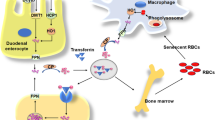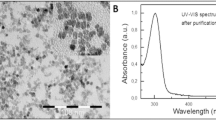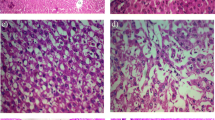Abstract
Iron has long been related to the pathological process of alcoholic liver disease (ALD). Liver iron overload is known to accelerate the development of ALD. In the present study we aimed to examine the effect of epigallocatechin-3-gallate (EGCG) on iron overload of ALD and to explore the potential mechanisms involved in its protection against ALD in mice. Male C57BL/6J mice were given alcohol by intragastric administration for 12 weeks. At the end of 8th week, ALD mice were treated for 4 weeks for 10, 20 and 30 mg kg–1 EGCG by intraperitoneal injection. Liver injuries were assessed by histopathologic examination and Serum Alanine Aminotransferase (ALT) levels. Serum iron content, hepatic iron concentration and liver malondialdehyde (MDA) contents were examined. In addition, hepcidin mRNA levels and transferrin (Tf) and transferrin receptor 1 (TfR1) protein levels of liver tissue were also evaluated. Compared with model group, treatment of ALD mice with EGCG ameliorated liver injuries, decreased serum iron level, hepatic iron levels and liver MDA contents, increased hepcidin mRNA level and decreased Tf and TfR1 protein expression in the liver. The results of our study explain a new point of view that the protective effect of EGCG on ALD is associated with its iron-chelating property. The possible mechanisms are that EGCG affects hepatic iron uptake and inhibits iron absorption in the small intestinal.





Similar content being viewed by others
References
Albano E (2006) Alcohol, oxidative stress and free radical damage. Proc Nutr Soc 65:278–290
Dey A, Cederbaum AI (2006) Alcohol and oxidative liver injury. Hepatology 43:S63–S74
Chapman RW, Morgan MY, Laulicht M, Hoffbrand AV, Sherlock S (1982) Hepatic iron stores and markers of iron overload in alcoholics and patients with idiopathic hemochromatosis. Dig Dis Sci 27:909–916
Potter BJ, Chapman RW, Nunes RM, Sorrentino D, Sherlock S (1985) Transferrin metabolism in alcoholic liver disease. Hepatology 5:714–721
Irving MG, Halliday JW, Powell LW (1988) Association between alcoholism and increased hepatic iron stores. Alcohol Clin Exp Res 12:7–13
De Feo TM, Fargion S, Duca L, Cesana BM, Boncinelli L, Lozza P, Cappellini MD, Fiorelli G (2001) Non-transferrin-bound iron in alcohol abusers. Alcohol Clin Exp Res 25:1494–1499
Whitfield JB, Zhu G, Heath AC, Powell And LW, Martin NG (2001) Effects of alcohol consumption on indices of iron stores and of iron stores on alcohol intake markers. Alcohol Clin Exp Res 25:1037–1045
Ioannou GN, Dominitz JA, Weiss NS, Heagerty PJ, Kowdley KV (2004) The effect of alcohol consumption on the prevalence of iron overload, iron deficiency, and iron deficiency anemia. Gastroenterology 126:1293–1301
Halliwell B (1978) Superoxide-dependent formation of hydroxyl radicals in the presence of iron chelates. Is it a mechanism for hydroxyl radical production in biochemical systems? FEBS Lett 92:321–326
Tsukamoto H, Horne W, Kamimura S, Niemela O, Parkkila S, Yla-Herttuala S, Brittenham GM (1995) Experimental liver cirrhosis induced by alcohol and iron. J Clin Invest 96:620–630
Valerio LG Jr, Parks T, Petersen DR (1996) Alcohol mediates increase in hepatic and serum nonheme iron stores in a rat model for alcohol-induced liver injury. Alcohol Clin Exp Res 20:1352–1361
Suzuki Y, Saito H, Suzuki M, Hosoki Y, Sakurai S, Fujimoto Y, Kohgo Y (2002) Up-regulation of transferrin receptor expression in hepatocytes by habitual alcohol drinking is implicated in hepatic iron overload in alcoholic liver disease. Alcohol Clin Exp Res 26:26S–31S
Gantz T (2004) Hepcidin in iron metabolism. Curr Opin Hematol 11:251–254
Knutson M, Wessling-Resnick M (2003) Iron metabolism in the reticuloendothelial system. Crit Rev Biochem Mol Biol 38:61–88
Nicolas G, Bennoun M, Devaux I, Beaumont C, Grandchamp B, Kahn A, Vaulont S (2001) Lack of hepcidin gene expression and severe tissue iron overload in upstream stimulatory factor 2 (USF2) knockout mice. Proc Natl Acad Sci USA 98:8780–8785
Nicolas G, Viatte L, Bennoun M, Beaumont C, Kahn A, Vaulont S (2002) Hepcidin, a new iron regulatory peptide. Blood Cells Mol Dis 29:327–335
Ganne-Carrie N, Christidis C, Chastang C, Ziol M, Chapel F, Imbert-Bismut F, Trinchet JC, Guettier C, Beaugrand M (2000) Liver iron is predictive of death in alcoholic cirrhosis: a multivariate study of 229 consecutive patients with alcoholic and/or hepatitis C virus cirrhosis: a prospective follow up study. Gut 46:277–282
Chapman RW, Morgan MY, Bell R, Sherlock S (1983) Hepatic iron uptake in alcoholic liver disease. Gastroenterology 84:143–147
Higdon JV, Frei B (2003) Tea catechins and polyphenols: health effects, metabolism, and antioxidant functions. Crit Rev Food Sci Nutr 43:89–143
Tedeschi E, Suzuki H, Menegazzi M (2002) Antiinflammatory action of EGCG, the main component of green tea, through STAT-1 inhibition. Ann N Y Acad Sci 973:435–437
Lambert JD, Yang CS (2003) Mechanisms of cancer prevention by tea constituents. J Nutr 133:3262S–3267S
Guo Q, Zhao B, Li M, Shen S, Xin W (1996) Studies on protective mechanisms of four components of green tea polyphenols against lipid peroxidation in synaptosomes. Biochim Biophys Acta 1304:210–222
Apak R, Guclu K, Ozyurek M, Karademir SE (2004) Novel total antioxidant capacity index for dietary polyphenols and vitamins C and E, using their cupric ion reducing capability in the presence of neocuproine: CUPRAC method. J Agric Food Chem 52:7970–7981
Stuart KA, Fletcher LM, Clouston AD, Lynch SV, Purdie DM, Kerlin P, Crawford DHG (2000) Increased hepatic iron and cirrhosis: no evidence for an adverse effect on patient outcome following liver transplantation. Hepatology 32:1200–1207
Powell LW (1975) The role of alcoholism in hepatic iron storage disease. Ann N Y Acad Sci 252:124–134
Sadrzadeh SM, Nanji AA, Price PL (1994) The oral iron chelator, 1,2-dimethyl-3-hydroxypyrid-4-one reduces hepatic-free iron, lipid peroxidation and fat accumulation in chronically ethanol-fed rats. J Pharmacol Exp therapy 269:632–636
Starke PE, Farber JL (1985) Ferric iron and superoxide ions are required for the killing of cultured hepatocytes by hydrogen peroxide. Evidence for the participation of hydroxy radicals formed by an iron-catalyzed Harber-Weiss reaction. J Biol Chem 260:10099–10104
Sakaida I, Kyle ME, Farber JL (1990) Autophagic degradation of protein generate s a pool of ferric iron required for the killing of cultured hepatocytes by an oxidative stress. Mol Pharmacol 37:435–442
Rothman RJ, Serroni A, Farber JL (1992) Cellular pool of transient ferric iron, chelatable by deferoxamine and distinct from ferritin, that is involved in oxidative cell injury. Mol Pharmacol 42:703–710
Sakaida I, Kayano K, Wasaki S, Nagatomi A, Matsumura Y, Okita K (1995) Protection against actaminophen-induced liver injury in vivo by an iron che lator, deferoxamine. Scand J Gastroenterol 30:61–67
Stal P, Johansson I, Ingelamn-Sundberg M, Hagen K, Hultcrantz R (1996) Hepatotoxicity induced by iron overload and alcohol. Studies on the role of chelatable iron, cytochrome P450 2E1 and lipid peroxidation. J Hepatol 25:538–546
Kyle ME, Sakaida I, Serroni A, Farber JL (1990) Metabolism of acetaminophen by cultured rat hepatocytes. Depletion of protein thiol groups without any loss of viability. Biochem Pharmacol 40:1211–1218
Tavill AS, Qadri AM (2004) Alcohol and iron. Semin Liver Dis 24:317–325
Shervington A, Pawar V, Menon S, Thakkar D, Rahima Patel R (2009) The sensitization of glioma cells to cisplatin and tamoxifen by the use of catechin. Mol Biol Rep 36:1181–1186
Jiao Y, Wilkinson JT, Christine Pietsch E, Buss JL, Wang W, Planalp R, Torti FM, Torti SV (2006) Iron chelation in the biological activity of curcumin. Free Radic Biol Med 40:1152–1160
Kumamoto ST, Nagayama K, Tabata M (2001) Effects of pH and metal ions on antioxidative activities of catechins. Biosci Biotechnol Biochem 65:126–132
Reznichenko L, Amit T, Zheng H, Avramovich-Tirosh Y, Youdim MB, Weinreb O, Mandel S (2006) Reduction of iron-regulated amyloid precursor protein and beta-amyloid peptide by (−)-epigallocatechin-3-gallate in cell cultures: implications for iron chelation in Alzheimer’s disease. J Neurochem 97:527–536
Grinberg LN, Newmark H, Kitrossky N, Rahamim E, Chevion M, Rachmilewitz EA (1997) Protective effects of tea polyphenols against oxidative damage to red blood cells. Biochem Pharmcol 9:973–978
Goodin MG, Bray BJ, Rosengren RJ (2006) Sex- and strain-dependent effects of epigallocatechin gallate (EGCG) and epicatechin gallate (ECG) in the mouse. Food Chem Toxicol 44:1496–1504
Abboud PA, Hake PW, Burroughs TJ, Odoms K, O’Connor M, Mangeshkar P, Wong HR, Zingarelli B (2008) Therapeutic effect of epigallocatechin-3-gallate in a mouse model of colitis. Eur J Pharmacol 579:411–417
Sugata M, Sarmistha B, Sudeshna M, Sukta D, Chinmay KP (2006) Epigallocatechin gallate induced apoptosis in Sarcoma180 cells in vivo: mediated by p53 pathway and inhibition in U1B, U4–U6 UsnRNAs expression. Apoptosis 11:2267–2276
Kohgo Y, Ohtake T, Ikuta K, Suzuki Y, Hosoki Y, Saito H, Kato J (2005) Iron accumulation in alcoholic liver diseases. Alcohol Clin Exp Res 29:189S–193S
Ganz T (2003) Hepcidin, a key regulator of iron metabolism and mediator of anemia of inflammation. Blood 102:783–788
Krause A, Neitz S, Magert HJ, Schulz A, Forssmann WG, Schulze Knoppe P, Adermann K (2000) LEAP-1, a novel highly disulfided-bonded human peptide, exhibits antimicrobial activity. FEBS Lett 480:147–150
Park CH, Valore EV, Waring AJ, Ganz T (2001) Hepcidin, a urinary antimicrobial peptide synthesized in the liver. J Biol Chem 276:7806–7810
Ohtake T, Saito H, Hosoki Y, Inoue M, Miyoshi S, Suzuki Y, Fujimoto Y, Kohgo Y (2007) Hepcidin is down-regulated in alcohol loading. Alcohol Clin Exp Res 31:S2–S8
Kohgo Y, Ohtake T, Ikuta K, Suzuki Y, Torimoto Y, Kato J (2008) Dysregulation of systemic iron metabolism in alcoholic liver diseases. J Gastroenterol Hepatol 23(1):S78–S81
Acknowledgements
The authors wish to thank Dr. Ruoting Long and Zhaohui Tang and postgraduate Lixian Su from the Southern Medical University for helping us during the study.
Author information
Authors and Affiliations
Corresponding author
Additional information
Yuan Ren and Fengjun Deng have contributed equally.
Rights and permissions
About this article
Cite this article
Ren, Y., Deng, F., Zhu, H. et al. Effect of epigallocatechin-3-gallate on iron overload in mice with alcoholic liver disease. Mol Biol Rep 38, 879–886 (2011). https://doi.org/10.1007/s11033-010-0180-5
Received:
Accepted:
Published:
Issue Date:
DOI: https://doi.org/10.1007/s11033-010-0180-5




